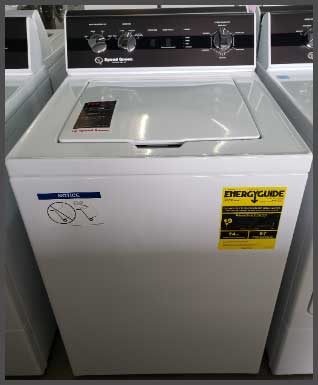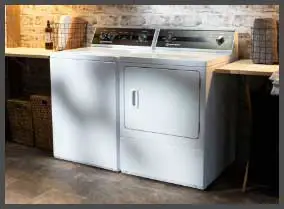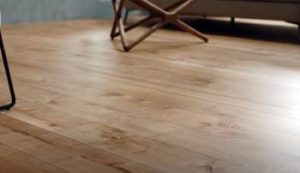Speed Queen top-load washers are known for their durability, long lifespans, and powerful cleaning performance. The TR3 and TR5 models are two of Speed Queen’s most popular machines, sharing many similarities but also key differences.
This comprehensive guide will compare the TR3 and TR5, looking at their design, features, performance, reliability, and more to help you decide which washer best fits your needs.
A Brief Comparison Table
| Feature | Speed Queen TR3 | Speed Queen TR5 |
| Controls | Mechanical knob | Electronic push button |
| Wash Cycles | 2 cycles | 6 cycles |
| Spin Speeds | 2 speeds | 4 speeds |
| Cycle Options | None | Sanitize, Soak, Delay Start |
| Capacity | 3.2 cu. ft. | 3.8 cu. ft. |
| Dimensions | 43 1⁄4” H x 27” W x 28” D | 44 1⁄4” H x 27” W x 28” D |
| Noise Level | 64 dBA | 64 dBA (higher at max spin) |
| Warranty | 3 years labor + 10 years limited parts | 3 years labor + 10 years limited parts |
| Price | $699 MSRP | $799 MSRP |
Overview of the TR3 and TR5

The TR3 and TR5 are both top-loading agitator washers with a classic design and robust construction meant to withstand years of frequent use.
The TR3 is Speed Queen’s entry-level washer, with basic features but still their trademark quality.
It has a 3.2 cu. ft. stainless steel wash basket and rugged commercial-grade components like a triple lip seal and steel ring.
The TR3 controls are simple mechanical dials without any digital displays or electronic controls.
This pared-down washer focuses on proven cleaning performance rather than bells and whistles.
The TR5 builds on the TR3 with additional cycles, a larger capacity, and more electronic controls while retaining Speed Queen’s solid build. It has a 3.8 cu. ft. stainless steel basket and the same enduring commercial-grade parts as the TR3.
The TR5 adds electronic controls with an LED display for cycle programming along with additional wash cycles. It’s designed to handle large loads for busy households.
Design Comparison
The TR3 and TR5 share a classic top-load washer design with an old-school centrally mounted agitator. Here’s an overview of how their constructions compare:
- Agitator – Both have a four-vane polypropylene agitator in the middle of the wash basket. This agitator swirls clothes through the water for an intense clean.
- Wash Basket – The TR3 has a 3.2 cu. ft. basket while the TR5 is larger at 3.8 cu. ft. Both are made from durable stainless steel. The ribbed basket design provides excellent water flow.
- Tub – They have a durable porcelain-coated steel outer tub that is rust and chip resistant. The TR5 tub is slightly bigger to accommodate the increased capacity.
- Body – The washers have a white galvanized steel body that’s powder coated for corrosion resistance. Both models also have leveling legs that can be adjusted to stabilize on uneven floors.
- Lid – The TR3 and TR5 lids are strong and lightweight with a unique design that removes the central bracing for maximum wash load flexibility.
- Dispensers – Each has a manual dispenser for bleach, fabric softener, and detergent. The dispensers conveniently dilute additives before they enter the wash.
- Drain – They drain via a bottom center drain that efficiently removes water with a dual action spin. The drain pump motor clears water at up to 135 gallons per minute.
So in summary, the TR3 and TR5 share fundamentally similar commercial-style constructions but the TR5 model steps up the capacity and convenience with its larger basket and tub.
Feature Comparison
While the TR3 and TR5 have comparable builds, their features and controls differ considerably:

- Controls – The TR3 has basic mechanical knob controls. The TR5 adds electronic controls with cycle programming, an LED screen, and additional cycle options.
- Cycles – The TR3 has just 2 cycles: Regular Wash and Permanent Press. The TR5 offers 6 cycles: Regular, Heavy Duty, Delicate, Whites, Perm Press, and Rinse Spin.
- Water levels – On the TR3 you select load size by water level only. The TR5 lets you select water level and spin speed separately.
- Spin speeds – The TR3 has high and low spin speeds. The TR5 adds a no spin option and faster maximum spin of 710 RPM vs 660 on the TR3.
- Cycle status lights – The TR5 has lights that display when a cycle is sensed, locked, in progress, or done. The TR3 does not have indicator lights.
- Damage prevention – The TR5 has a cylinder switch that detects imbalanced loads and prevents damage. The TR3 does not have this protection.
- Delay start – Only the TR5 provides delayed start functionality to program a wash for later.
- Specialty cycles – The TR5 adds a rinse spin cycle lacking on the TR3. Only the TR5 has a soak option.
So in summary, the TR3 is extremely basic while the TR5 offers more convenience and flexibility with additional cycle options, electronic controls, and specialty features. But the fundamentals remain solid on both models.
Cleaning Performance
With their commercial-grade components and traditional top-load design, both the TR3 and TR5 offer exceptional wash performance:
- High speed wash action – The four-vane agitator provides vigorous cleaning by rapidly circulating clothes through water.
- Powerful motor – These washers have a durable 0.9 HP motor that produces high spin speeds for fast water extraction.
- Sanitary cycle – The TR5 adds a sanitary cycle that heats water up to 162°F to eliminate bacteria and allergens.
- Stain removal – The heavy duty and soak cycles available on the TR5 boost stain fighting by extending wash times and allowing clothes to soak.
- Auto balancing – They self-adjust during spin cycles, automatically redistributing loads for reduced vibration.
- Efficient water usage – Fill levels can be adjusted to match load sizes so water isn’t wasted. The TR5 with electronic controls offers more precision.
- Durable stainless tub – The rugged stainless steel tubs resist abrasion, staining, and odors even after years of washing.
While the TR5 does offer some additional heavy duty cycles, at their core both models deliver Speed Queen’s signature cleaning performance and should handle any type of laundry.
For most households, the basic TR3 wash cycles will be sufficient to tackle stains, deep clean fabrics, and keep clothes fresh. The TR5 provides extra options for those needing maximum stain fighting power.
Also Read: Comparison of Bosch And Cove Dishwasher.
Reliability and Durability
All Speed Queen washers are designed for longevity, and the TR3 and TR5 are no exception with their sturdy builds:
- Robust components – The commercial grade transmission, motor, steel shaft, and sealed bearings are built to last through decades of use.
- Metal construction – Key parts like the wash basket, outer tub, base, and body are steel and porcelain-coated steel rather than plastic.
- Triple lip seal – This specialized gasket keeps water contained and prevents leaks while allowing the agitator shaft to move freely.
- Industrial strength – Speed Queen machines are engineered to withstand up to 180,000 wash cycles, equivalent to 25 years of home use.
- In-house manufacturing – They are assembled in Ripon, Wisconsin using stringent quality control standards.
- Solid warranties – The TR3 and TR5 have 3-year parts and labor warranties along with impressive 10-year limited parts warranties.
While the TR5’s electronic controls and programming could potentially be more prone to issues, the lack of motherboards and complicated electronics on these simple machines make reliability concerns very minimal. Both models are built to provide decades of dependable service.
Noise Levels
These powerful top-load agitator washers do tend to be a bit louder than your average washer. Here’s how the TR3 and TR5 compare:
- Operational noise – Both run at about 64 dBA, louder than many front load washers but comparable to other top load models.
- Spinning noise – The TR5 spins faster at 710 RPM vs 660 on the TR3, which translates to a slightly higher noise level. But not dramatically so.
- Vibration – Their heavy duty construction prevents excessive shaking or vibration. Auto balancing features also help minimize vibration issues.
- Noise insulation – Neither model has special sound dampening features or insulation that help reduce operational noise. The metal construction can amplify sounds.
So in summary, these washers are not the quietest, but this is expected for their design and durability level. The TR5 produces marginally more noise during max speed spin cycles compared to the TR3 but overall noise levels are similar.
For most homeowners, the noise is worth the superb cleaning and reliability you get from these Speed Queen models. But they may not be ideal for apartments or other situations where low noise is critical.
Size and Dimensions
As you consider space for installing these washers, here are the key dimensions:
Speed Queen TR3 Dimensions:
- Height: 43 1⁄4”
- Width: 27”
- Depth: 28”
Speed Queen TR5 Dimensions:
- Height: 44 1⁄4”
- Width: 27”
- Depth: 28”
The TR5 is slightly taller but otherwise the dimensions are identical. Make sure you have the proper electrical connections available as well – both models require 120-volt outlets.
The washers are also fairly heavy, weighing about 145 pounds for the TR3 and 170 pounds for the TR5. Two people are recommended for moving and installing them.
Overall, there are minimal size differences between the two models. The TR5 is able to fit larger loads in essentially the same footprint thanks to clever basket and tub optimization.
Also Read: Comparison of Miele And Cove Dishwashers.
Cost Comparison
As Speed Queen’s lower-end model, the TR3 is more affordable than the TR5. Here’s an overview of their typical pricing:
- Speed Queen TR3 – MSRP of $799, retail price around $699
- Speed Queen TR5 – MSRP of $899, retail price around $799
Specific pricing can vary a bit by retailer. Additional charges may apply for freight/shipping if not picking up locally.
There are almost always various rebates and seasonal discounts available that can drop prices $50-100 lower than MSRP. Speed Queen also occasionally offers promotional interest financing.
Overall, expect to spend about $100-150 more for the TR5 over the TR3. From a cost perspective, the TR3 provides better value if you want basic washing functionality and legendary reliability. But the TR5 is worth the extra cost for many buyers who want those additional cycles and electronic controls.
Pros and Cons of the Speed Queen TR5
Pros:
- More wash cycles for optimal fabric care
- Sanitize cycle kills bacteria and allergens
- Electronic controls and LED display for precision
- Delay start conveniently programs wash time
- Soak cycle boosts stain removal
- Faster max spin speed = quicker drying
- Larger 3.8 cu. ft. capacity
Cons:
- Higher price tag
- Electronic control panel may impact longevity
- Slightly louder during max spin cycle
Pros and Cons of the Speed Queen TR3
Pros:

- Proven cleaning performance
- Extreme durability and longevity
- Simple mechanical controls won’t break
- Lower purchase price
- Quick wash time/efficient performance
Cons:
- Just 2 basic wash cycles
- No specialty cycles like Sanitize or Soak
- No delay start function
- Max spin speed slower than TR5
- Smaller 3.2 cu. ft. capacity
Also Read: Comparison of Bosch And Cafe Dishwasher.
Frequently Asked Questions (FAQ)
The TR3, TR5, and TR7 represent good, better, and best within Speed Queen’s top-load washer lineup.
TR3 – Entry-level model with simple mechanical controls and basic washing cycles. Still has commercial grade components for durability. Great value.
TR5 – Mid-range model adds electronic controls, extra wash cycles, higher spin speed. Ideal balance of power and price.
TR7 – Flagship washer has large 4.5 capacity, touch screen controls, upgraded motor, and maximum number of cycles. The most features and highest price.
The TC5 is Speed Queen’s front load washer. It focuses more on gentle fabric care and energy efficiency. The TR5 is a top load washer with traditional agitator design that provides intense cleaning action. Otherwise they share similar cycles, capacity, and electronic features. Main difference is cleaning approach.
Speed Queen washers are designed to handle up to 25 years of residential use, equivalent to around 180,000 wash cycles. Their all-metal construction and commercial grade parts allow them to easily outlast most other consumer washing machines. With proper maintenance, a 15-20 year lifespan is common for Speed Queen top load models like the TR3 and TR5.
Yes, the Speed Queen TR5 has a traditional four-vane agitator in the center of its stainless steel wash basket. This agitator churns and swirls clothing throughout the cycle to deliver a rigorous clean. The agitation wash motion is ideal for removing stains and preventing soils from embedding in fabric. It’s a defining feature of Speed Queen’s durable top load washer design.
Bottom Line
For most buyers, the Speed Queen TR5 is worth the extra $100-150 over the TR3. It retains all the durability that makes Speed Queen washers legendary while adding more cycles, better controls, and improved convenience features. The TR5 is ideal for large families that need to clean lots of laundry.
But the TR3 remains a solid choice if you want basic washing functionality with time-tested reliability. Given its pared down controls and features, the TR3 is likely to enjoy an even longer lifespan than the electronically controlled TR5. It’s perfect for buyers who do mostly light to moderate laundry loads.
Ultimately you can’t go wrong with either washer – Speed Queen’s world-class construction shines through. Pick the TR5 for maximum cleaning power and flexibility or the TR3 for no-frills dependability.
Let us know if you have any other questions as you make your decision between these two excellent Speed Queen washers!



